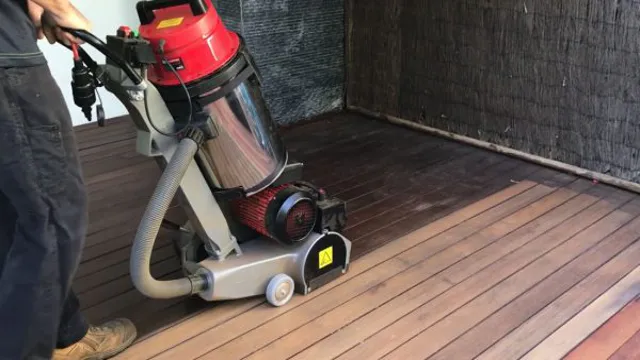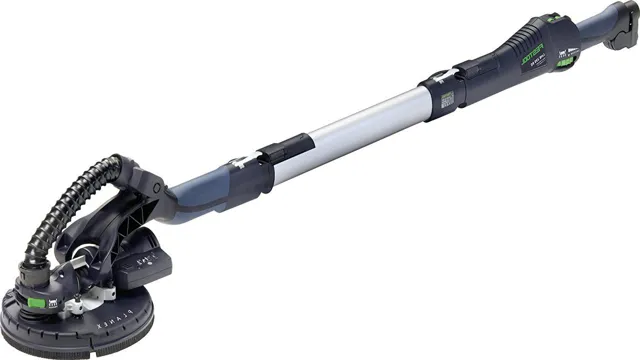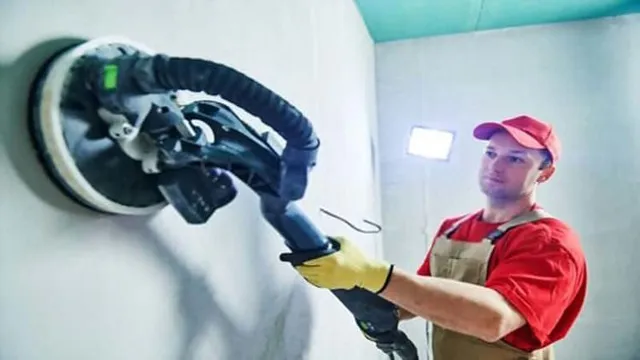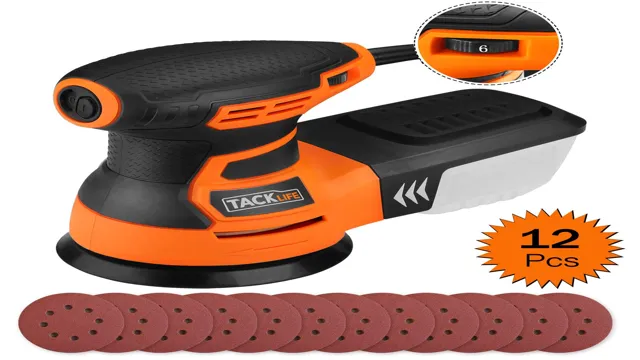Can a Drywall Sander be Used on Wood Floors? Explore Your Sanding Options
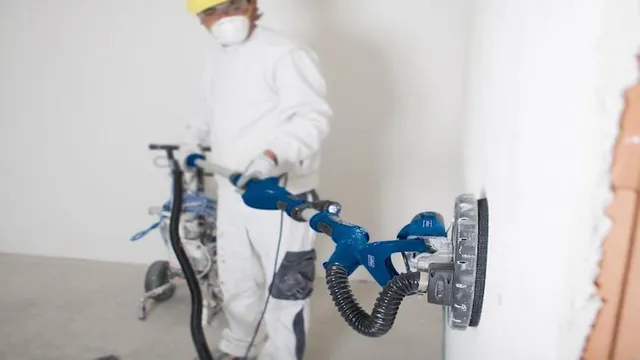
Have you ever wondered if you can use a drywall sander on wood floors? If you’re someone who enjoys DIY projects and home renovations, you may have considered giving your wood floors a fresh new look. Sanding is an integral aspect of refinishing or restoring old floors, but what if you only have a drywall sander at your disposal? Can it get the job done? In this blog post, we’ll explore whether or not using a drywall sander on wood floors is a good idea and what you need to consider before you start your sanding project. So, let’s dive in and find out!
Understanding Drywall Sanders
If you’re wondering if you can use a drywall sander on your wood floors, the answer is no. While drywall sanders are great for smoothing out rough surfaces, they are not designed for use on wood floors. Drywall sanders are specifically designed for use on drywall, plaster, and other similar materials.
Using a drywall sander on a wood floor could result in irreparable damage to the surface of the floor. Instead, it’s best to use a floor sander specifically designed for use on wood floors. These sanders are specially designed to sand wood floors without causing any damage to the surface.
So, if you’re looking to sand your wood floors to refinish them, make sure to use the right tool for the job.
What is a drywall sander and how does it work?
A drywall sander, as its name implies, is a tool mainly used for smoothing and polishing drywall surfaces like walls and ceilings. It is equipped with a sanding pad or sandpaper that rotates at high speed to remove rough spots, bumps, and other imperfections that may occur during the installation of drywall sheets. A drywall sander is particularly useful in the process of sanding drywall mud or joint compound that is applied to cover the spaces between drywall sheets.
This tool eliminates the need for manual sanding, which can be really tiring and time-consuming. It also creates less dust while working, which makes it more convenient and safer to use. To use a drywall sander, it is attached to a dust collection system that sucks up the dust and debris produced during sanding.
The result is a smooth and even drywall surface that can be painted or finished as needed. Overall, a drywall sander is an essential tool for any drywall installation project that requires a smooth and uniform surface finish.
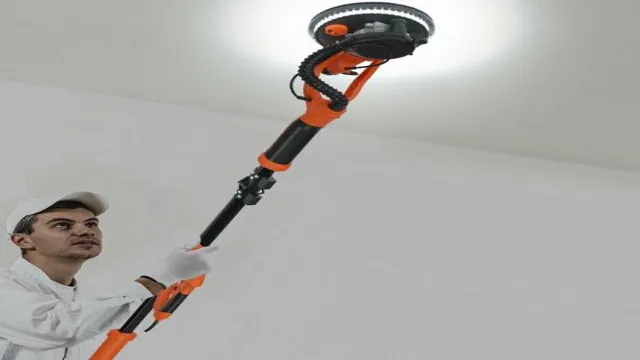
Comparing Wood Floors and Drywall
While drywall sanders are typically used on drywall to smooth down surfaces and remove any rough patches, they can also be used on wood floors. However, it’s important to note that drywall sanders designed for drywall might not be able to handle the rigors of sanding wood floors. That’s because wood floors are often harder and more durable than drywall, which can lead to faster wear and tear on a drywall sander.
Additionally, drywall sanders are typically designed to be used in small, confined spaces rather than larger rooms. This means that using a drywall sander on a wood floor might require a lot of extra time and effort on your part. Overall, while a drywall sander might be able to handle some minor smoothing on wood floors, it’s typically better to invest in a specialized sander designed specifically for wood floors.
Differences in Material and Surface Preparation
When it comes to material and surface preparation, there are significant differences between wood floors and drywall. Wood floors require more attention to detail and care when it comes to surface preparation. The surface should be clean, dry, and free from any debris or stains.
Any protruding nails or screws should be removed, and the surface should be sanded down to a smooth finish. The type of wood, its thickness, and its condition will also impact how much preparation is needed. On the other hand, drywall is a less demanding material when it comes to surface preparation.
The walls need to be clean and free from any cracks or holes. The surface should also be sanded down, so there is no roughness, but this can be achieved easily with basic tools. Additionally, the type of drywall and its thickness will not usually impact how much preparation is needed.
In summary, both wood floors and drywall require some degree of preparation, but wood floors are more demanding and require more attention to detail.
Machine Strength and Abrasive Power
When it comes to comparing the machine strength and abrasive power of wood floors and drywall, there are a few key differences to keep in mind. Wood floors are typically stronger and more durable than drywall, as they are designed to withstand foot traffic and heavy loads. However, drywall can be tough and resistant to impact, which makes it a popular choice for home construction and renovation projects.
Overall, the machine strength and abrasive power of wood floors and drywall depend on the specific application and intended use. So, whether you’re installing a new floor or renovating your home, be sure to choose a material that can handle the wear and tear of everyday use.
Can You Use a Drywall Sander on Wood Floors?
If you’re wondering whether or not a drywall sander can be used on your wood floors, the answer is yes, but it may not be the most effective way to get the job done. While a drywall sander can effectively sand and smooth out drywall, it may not be powerful enough or have the proper attachments to remove tough stains or deep scratches from your wood floors. Additionally, drywall sanders may leave marks or swirls on your wood floors if not used carefully.
It’s important to consider investing in a specialized floor sander, which can provide the necessary power and attachments to properly sand and smooth out your wood floors without causing damage. However, if you only need to sand a small area or do some light sanding, a drywall sander can be effective, but be sure to use caution and proper technique to avoid any damage to your wood floors.
Risks and Potential Damage to Wood Floors
Using a drywall sander on your wood floors can be tempting, especially when you are trying to smooth out rough patches or remove old finishes. However, using a drywall sander on wood floors can lead to potential risks and damage. While drywall sanders are intended for use on drywall, they are not designed for use on bare wood.
Using a drywall sander on wood floors can cause deep scratches and uneven patches that can be difficult, if not impossible, to repair. Additionally, drywall sanders can generate a lot of dust, which can get into cracks and crevices, making it difficult to clean up. So, it is best to avoid using a drywall sander on your wood floors and instead use a more appropriate tool that is specifically designed for wood floors.
Using proper tools and techniques can help prevent damage and prolong your wood floor’s lifespan.
Alternatives to Drywall Sanders for Wood Floors
When it comes to sanding wood floors, many people wonder if they can use a drywall sander. While drywall sanders are designed for use on walls and ceilings, they can be used on wood floors. However, it’s not the best option, as drywall sanders are often too aggressive and can cause damage to the wood.
Instead, there are several alternatives to drywall sanders that are better suited for sanding wood floors. These include orbital sanders, belt sanders, and drum sanders. Each of these sanders has its own unique characteristics and is designed for use in different situations.
For instance, an orbital sander is great for removing light scratches and smoothing out rough spots, while a drum sander is ideal for sanding large areas quickly. Ultimately, the best sander to use on your wood floors will depend on a variety of factors, including the condition of your floors, the type of wood, and your personal preferences.
Conclusion
Unfortunately, no matter how hard you try to make it work, a drywall sander is just not meant to be used on wood floors. Just like how a hammer isn’t the best tool for painting your nails, there’s a time and place for everything. So let’s leave the drywall sander for its intended use and give our precious wood floors the care and attention they deserve.
“
FAQs
Can a drywall sander be used on wood floors?
No, drywall sanders are not designed to be used on wood floors. They are specifically designed for sanding drywall and may damage the surface of wood floors.
What type of sander is best for wood floors?
The best type of sander for wood floors is a drum sander. They are designed to remove the top layer of hardwood flooring and create a flat, smooth surface.
Can I use a palm sander on wood floors?
Yes, you can use a palm sander on wood floors for small areas or sanding in between the boards. However, for larger areas, a drum sander is recommended.
Can I sand wood floors myself or should I hire a professional?
If you have experience with DIY projects, then you can sand wood floors yourself. However, if you are inexperienced, it is recommended to hire a professional to avoid damaging the flooring.
What grit sandpaper should I use on wood floors?
It depends on the condition of the floor. If the surface is rough, start with a coarse grit sandpaper (60-80 grit), and gradually use finer grits (120-220 grit) for a smoother finish.
Do I need to remove furniture before sanding wood floors?
Yes, all furniture and belongings should be removed from the room before sanding wood floors. This ensures that the entire surface of the floor is accessible for sanding.
How long do I need to wait before staining or sealing wood floors after sanding?
It is recommended to wait at least 24 hours after sanding before staining or sealing wood floors to ensure the surface is completely dry and free of any dust from sanding.

